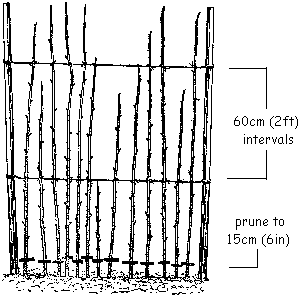Categories
Calendars
Guides
- Help on the Allotment
- Greenhouse World
- The Perfect Lawn
- Water Garden Features
- Beginner's Corner
- Pest and Disease
- Garden Techniques
Reviews
Archive
Gallery
Articles
Ask Our Gardening Expert
How to Plant Raspberry Canes
How to Plant Raspberry Canes
When
and How To Plant Raspberries
October
is the best month to plant raspberries, although
planting can be done any time up to March
if the weather and
soil conditions are correct.
Most soils are suitable for raspberries, but a little preparation will pay rewards, especially because they will remain in the same position for 10 to 12 years. Dig a row 30cm (1ft) deep by 1m (3ft) wide, working in as much well rotted compost as possible. Where more than one row is being planted, allow 1.7m (5ft) between rows in order to let the roots spread freely and give room for you to harvest the crop in summer.
 Summer
fruiting raspberries (the most common for gardeners) will
require support during the growing season. Put the support poles
and wires in place after digging, but before planting. Secure
two 2.2m (7ft) poles in the ground at either end of the row. Tie
two or three horizontal wires at 60cm (2ft) intervals to the
poles. Tie the plants loosely to the wires when they begin to
grow.
Summer
fruiting raspberries (the most common for gardeners) will
require support during the growing season. Put the support poles
and wires in place after digging, but before planting. Secure
two 2.2m (7ft) poles in the ground at either end of the row. Tie
two or three horizontal wires at 60cm (2ft) intervals to the
poles. Tie the plants loosely to the wires when they begin to
grow.
Place the plants in the trench about 45cm (18in) apart, and cover the roots with soil 5cm (2in) above the existing soil mark on the stem. This will encourage more vigorous rooting. Work a handful of bonemeal per square metre (3ft) into the surface of the soil. Firm down the soil by lightly treading it down and water if the soil is not moist.
Finally, cut the plants to 15cm (6in) from the ground as shown in the diagram above. This may seem a bit drastic but if the correct pruning for the first year is not carried out, the plants will be seriously weakened.
Autumn fruiting raspberries do not require strong supports, and therefore do not need to be planted in rows. Simply devote an area to them and let them grow as they want. The plants will mostly support themselves with only the odd bit of help from some sticks in strategic positions.


